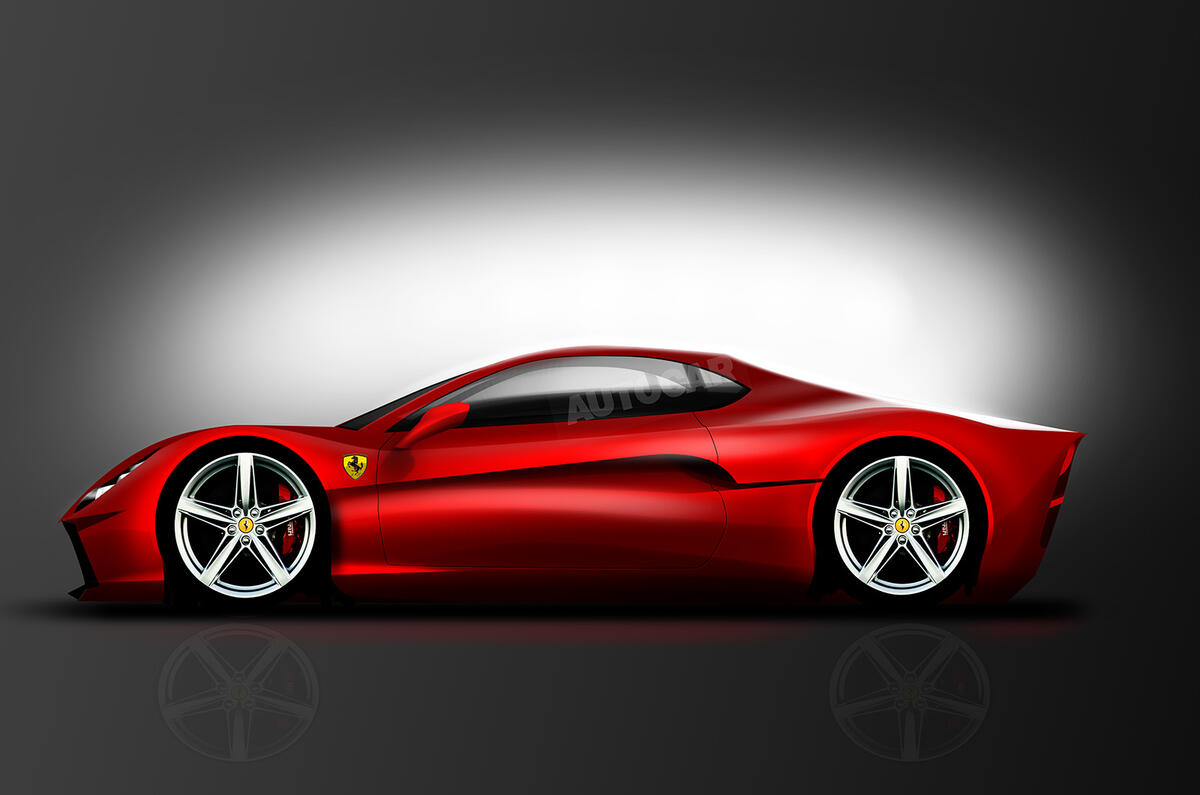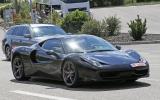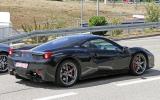A new, V6-powered Ferrari Dino sports car is due to launch in 2018.
Visual proof that Ferrari was working on a new vehicle to carry the Dino name came earlier this year, when the first test mules were spotted. Ferrari chief Sergio Marchionne revealed to Autocar earlier this year that it was “not a question of if but when” the Dino would return.
Our spy photographer said the early test mule, which was based on a Ferrari 458 Italia, had an engine note completely different from that of both the naturally aspirated 4.5-litre V8 in the 458 Italia and the turbocharged 3.9-litre V8 of the 488 GTB that was following the car in convoy.
The 458 Italia’s central exhaust system was also missing. Instead, there were two empty holes cut into the rear bumper just above the diffuser. The mule likely had an exhaust system that exits within the confines of the engine bay and original bumper, hinting at the fitment of a different, shorter powertrain.
It was noted that the sound was more akin to that of the twin-turbocharged 3.0-litre V6 that’s been testing in the Alfa Romeo Giulia Quadrifoglio Verde. This 503bhp engine has been developed by Ferrari and is understood to be the basis for the engine destined for the new Dino.
When speaking about the Dino's return, Marchionne also confirmed to Autocar that work on the V6 engine was ongoing at Ferrari and that the reception to it had been “positive”.
Further clues as to the model’s identity came from the 'cut and shut' nature of the bodywork. The rear body was different to that of the 458 Italia, with the Dino mule sporting shorter doors and a shorter rear section to those of the 458 Italia, along with larger and different-shaped side air intakes to provide cooling to the engine. There also appeared to be changes to the rear wheel arches, suggesting a different engine mounted underneath.
The mule was spotted in Germany rather than near Ferrari’s Maranello headquarters. The red-on-white numberplate is used for pre-production prototypes in Germany, and the 'HN' on this plate suggests that the mule comes from the town of Heilbronn, which is close to the headquarters of engineering and electronics specialist Bosch.
Ferrari and Bosch are understood to work together on advanced engineering and software projects, and this prototype indicates that Bosch is involved in the development of the V6 running gear for the new Dino.
Ferrari has recently posted a whole host of new technology patents, which could relate to the engine of its forthcoming £150,000 Dino sports car.
One is for a 'combustion engine with partial cylinder deactivation', which describes an engine in which one bank can be deactivated during low-load situations. This alludes to each cylinder bank having been separately designed with low and high-performance applications in mind, and the illustrations show a six-cylinder engine. Patent illustrations are frequently purely for reference, however, rather than being indicative of a final design.
This patent is also extended to one for an ‘internal combustion engine (turbo) with provision of cylinder deactivation at low load', essentially a version of this technology for turbocharged engines. Similar technology is currently demonstrated in the upcoming Alfa Romeo Giulia, which may be the first production application of Ferrari's aforementioned patent.
A more forward-looking patent is for a 'turbocharger provided with an electrical machine for a supercharged internal combustion engine'. This is something Ferrari is understood to have been experimenting with for some time. It includes an electric motor integrated into the turbo itself, spinning it and thus eliminating lag, as well as recovering energy during coasting phases.
A less specific patent application is for a new ‘high-performance sports car’, but this won’t be published until 15 October 2016 and there are no details alongside it. This could hint at a date for the Dino to be shown, but equally could be a more general patent application covering any future Ferrari.
Read more on the Ferrari Dino, first published June 4 2015
The iconic Ferrari Dino is set for a sensational comeback to the Prancing Horse’s range, most likely as a new £150,000 mid-engined sports car powered by a twin-turbocharged V6 engine.
The prospect of the Dino’s return to the Ferrari range after a four-decade-long absence has been spoken up directly by recently-appointed Ferrari chairman Sergio Marchionne, who told Autocar that the revival of the Dino name was “not a question of if but when”.
One of Ferrari’s most iconic names, Dino was used on V6 and V8-powered models in the 1960s and 70s as Ferrari sought to make more affordable but no less desirable cars under a new sub-brand, and push up volumes.
However, while plans are now afoot inside the company to see a return for the Dino name and V6 engines, such a model should not be seen as following historical precedent in what it stands for.
Marchionne insists Ferrari has no plans in significantly pushing up volumes, entering a lower price point or indeed launching another sub-brand, as was the case with the original introduction of the Dino badge.
“We may produce a 500 horsepower Ferrari but it will not be a cheap Ferrari,” he said. “The brand is unique and needs to be protected. I would always rather build 500 fewer cars than the market demanded rather than 500 more. We must not mess with customer expectations of Ferrari as an exclusive brand.”
These comments raise the intrigue on where the new Dino will sit in currently four-strong Ferrari range alongside the California T, 488 GTB, F12 and FF. One option could be as a radically different replacement for the California T coupe-convertible, which is due in 2018.
The California T, as critically and commercially well received as it has been, has never quite had the extra layer of sporting pretence, desirability and resonance with aficionados as the greatest Ferraris.
That said, the California T has opened up Ferrari to a new customer base, those looking for a more livable coupe-convertible GT car, and the profitable segment is one it is unlikely to want to turn its back on.
The Dino is therefore most likely to join the range as a fifth model line, being a truly sporting, mid-engined model sat in parallel to the California T, giving customers the option of a more traditional Ferrari sporting experience at the same price point.
But while placed on a price parallel as the California T, the Dino will live up to its historical roots by being a true sports car, one that’s mid-engined, unlike the front-engined California T.
A front-engined Dino would be at odds with Marchionne’s acknowledgement that the new Dino must be ‘done right'. “You’re right,” he said, “which is why it is so important to get it right. And it would be a wrong association to make Dino just a cheaper Ferrari.”
Such a model would give Ferrari a razor-sharp sports car to compete with the likes of the Porsche 911 GT3 RS.
In line with Marchionne’s comments of the new Dino being anything but a cheaper, entry-level Ferrari, the new model would still command a price tag of around £150,000, the same as the California T, although that figure is more likely to be higher than £150,000 than lower.
While details of the car’s exact make up are scarce at present, all the signals coming from Ferrari point to it being powered by a V6 engine.
Ferrari has long been in the process of making its engines more efficient, adopting stop-start systems and turbocharging on the California T and 488 GTB, and even downsizing the engine in the case of the 488 GTB.
The new supercar has a twin-turbo 3.9-litre V8 engine in place of the normally aspirated 4.5-litre V8 from the 458 Italia, which is both significantly more powerful and has greatly reduced CO2 emissions.
Marchionne said that the results of internal investigations into the feasibility of a V6 engine had been “positive”. Indeed, Ferrari already makes twin-turbo V6 engines for Fiat Chrysler Automobiles (FCA) sister brand Maserati.
Continuing the downsizing trend to smaller and even more efficient V6 engines is the next logical step for Ferrari, not least because it will soon be spun off as a separate company away from FCA and can no longer rely on its place in the wider FCA group when CO2 emissions are averaged out to meet legislative targets.
“We had to move to turbo because we need to reduce CO2 emissions and with the spin off Ferrari will be an independent company and cannot use the FCA fleet average,” said Marchionne. “On top of that credits [where a manufacturer can buy their way out of building zero emission vehicles] cannot be bought in Europe and China but only in US. Saying that it is clear that we are not the problem with 7000 cars per year, but we have to respect the legislation.”
A twin-turbocharged V6 engine would significantly help reduce Ferrari’s CO2 emissions on its current annual production volumes of 7000 units, not least because the Dino would make up a larger proportion of sales than the other models, naturally bringing the average down. However, whether or not Ferrari’s production volumes stay at 7000 units after the Dino’s introduction is another matter.
While being super-efficient, the new Ferrari V6 engine would certainly not want for performance. Marchionne’s hint at a 500hp (493bhp) output would see it match the 911 GT3 RS for power, and make a 0-62mph time of sub-3.5sec and a top speed close to 200mph achievable.
Such a car would have the added advantage of allowing Ferrari to play in the growing ranks of junior supercars populated by the likes of the 911 GT3 RS and Aston Martin V12 Vantage S, and the forthcoming Mercedes-AMG GT Black Series and McLaren 570S, albeit with the price and prestige premium that comes with a Ferrari.
Dino – what’s in a name?
Alfredo ‘Dino’ Ferrari was Enzo Ferrari’s elder son. He was born in 1932 but tragically died aged just 24 from muscular dystrophy.
He is credited with being the inspiration for the series of V6 engines that would power Ferrari F1 and sports racing cars such as Mike Hawthorn’s 1958 F1 World Championship winner and the exquisite 206SP.
In 1968 Ferrari launched Dino as an entire automotive brand in its own right with the Pininfarina-designed 2-litre, V6 Dino 206GT. The car had a claimed 180bhp but was replaced the following year by the 2.4-litre, 195bhp 246GT, though much of its potential performance advantage was obviated by the fact the 206’s aluminium body was replaced by steel.
Other ways to tell a 206 from a 246 is that the former had an exposed fuel filler and centre-lock ‘knock-on’ wheels.
Neither model carried a Ferrari badge or prancing horse motif anywhere inside or out: even its cam covers carried a simple ‘Dino’ interpretation of Alfredo’s signature.
The Dino 246GT was replaced by the Bertone-style 2+2 308GT4 in 1974 and though some early cars were badged as Dinos, by 1976 all were being sold as pure Ferraris and the Dino brand fell into disuse.
Dino Ferraris are massively sought after today and considered among the most desirable of Ferrari road cars today despite performance that, by modern standards, is decidedly modest.
Beautiful to look at, even better to listen to and possessed with the most exquisite handling, over 40 years after its death, the 246GT could still provides a guiding light for an all new generation of modern Dinos.
Additional reporting by Andrew Frankel and Lewis Kingston
Read more:
Blog - Ferrari Dino's revival is the first evidence of Marchionne's direction
Get the latest car news, reviews and galleries from Autocar direct to your inbox every week. Enter your email address below:

























Join the debate
Add your comment
New 8C?
I think, based on announcements from FCA, this should be the new inappropriately named Alfa Romeo 8C, with the Quadrifoglio engine plus hybrid power. Not a Ferrari or a Dino or a Maserati.
If Ferrari are not careful
Numbers